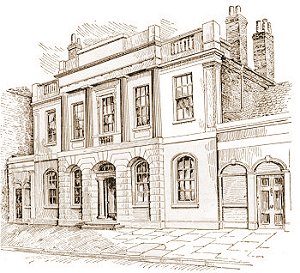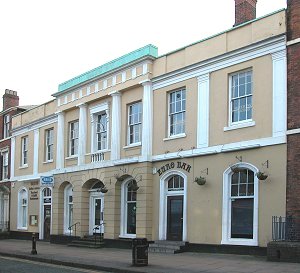Wolverhampton Dispensary, the City's first hospital, opened its
doors on Tuesday 10th July, 1821 at number 46 Queen Street. It
was established to cater for the medical and surgical needs of
the poor who could not afford to pay for the service themselves.
Mr. John Freed Proud, a well-known Wolverhampton surgeon from
North Street was instrumental in fund raising for the setting up
of the institution. On 5th January, 1820 a letter from him was
published in the Wolverhampton Chronicle mentioning the great
sickness amongst the poor owing to hard times.
The following year an announcement appeared in the Wolverhampton
Chronicle on April 4th:
Wolverhampton Dispensary
Endeavours are making to establish a Dispensary
in this town, and a meeting of the inhabitants of the town and
neighbourhood who are disposed to support it, is appointed to be
held at the Public Offices on Monday next. The advantage of such
an institution to a populous district like this, must be obvious
to everyone, and we trust the benevolent design will be speedily
carried into effect.
Intended Dispensary at Wolverhampton
THE SUBSCRIBERS and those Ladies and Gentlemen
who are disposed to support this Institution are requested to
meet at the PUBLIC OFFICE on MONDAY APRIL 9th, at Eleven, to
take into Consideration the Measures most likely to promote the
Design.
The meeting was duly held and well attended, with
Sir John Wrottesley, Bart. in the chair. It was decided that it
would be highly desirable to establish such an institution in
Wolverhampton and to form a provisional committee for the
purpose of collecting subscriptions. Members for the County, and
Noblemen and Gentlemen in any way connected with the district
were asked to support the fund.
Further meetings were held in which plans and rules for the
Dispensary were drawn up and an advertisement was placed for a
resident surgeon and an apothecary. By the middle of May the
fund amounted to £483.4s.9d and at a meeting of the subscribers
at the Swan Hotel it was decided that the Right Hon. Lord Dudley
and Ward would be requested to accept the office of President of
the Institution and the following gentlemen should be Vice
Presidents:
E.J. Littlejohn
Sir John Fenton Boughey, Bart.
Sir John Wrottesley, Bart.
Francis Holyoake, Esq.
James Hordern, Esq.
Richard Fryer, Esq.
Sir John Wrottesley, Bart. and Francis Holyoake,
Esq. were requested to act as treasurers, Dr. Dehane and Dr.
Mannix were to be physicians and Mr. Fowke and Mr. Proud,
surgeons. Mr. E.H. Coleman was asked to be house surgeon. The
choice of Lord Dudley and Ward as President was appropriate
because he had contributed large sums of money to the erection
of the building and played a considerable part in its affairs.
A house was acquired in Queen Street, one of the
most important streets in the town and fitted out with six beds
for inpatients and made ready for use.
|
|

The Dispensary in 1821.
|
From its opening in 1821 the Dispensary proved to be
very popular with 1852 patients treated in the first year. Patients
were required to produce a ticket of recommendation, which was paid
for by contribution or obtained from a contributor to the
Dispensary. Patients also had to pay a fee for extras such as
trusses, for which 1s was charged for a single truss or 2s for a
double truss. The patient's spiritual welfare was also considered by
the house visitors who were appointed each month by the Board of
Management and two bibles were made available for the purpose. |
The Board met weekly and apart from overseeing the
day to day running of the institution they considered the
suitability of patients for admittance and gave permission for
patients to be discharged. The running costs for the first year
amounted to £350 and although admissions fell over the next seven
years the annual running costs increased to £492.10s.8d.
Within three years of opening a larger building was required. A
committee consisting of Sir John Wrottesley, Bart.; Rev. W. Leigh;
Rev. E. Burton; Mr. Jesson; and Mr. Pearson looked into the matter
and at the end of 1824 they recommended that a new dispensary should
be erected and completed within a matter of months at an estimated
cost of £1,600. Subscriptions for the new building were collected
from local nobility and gentry, mainly as a result of the numerous
charity balls that were held in the Queen Street Library and News
Room. A total of £964 was collected and the building was extended to
add a further 14 beds. The new facility opened in July 1826. There
is some uncertainty about the architect, who is believed on
stylistic grounds to have been William Hollins from Birmingham. |
|
In 1833 the building was again extended at the
rear to contain casualty wards due to the increased demand for
beds for accident victims. £700 was raised for the extension
which gave room for a further 16 beds. By 1838 the resident
staff consisted of one Surgeon at £80 per annum, a Matron at £25
per annum, a Dispenser at £50 per annum and a number of servants
at £8 each per annum. The number of patients continued to
increase and during 1838 an extra 650 people were treated. This
was mentioned at the 1839 A.G.M. and a request was made for a
permanent nurse for the wards. It is not known if such a nurse
was employed at the time, but in 1842 Mrs. Shinton was employed
in the post at a salary of £4.4s per annum.
|

The dispensary building today.
|
| The house surgeon used to make house-calls on
patients living with 1 mile of the Dispensary and also had to report
to the committee every month to give the names of patients on the
wards and their date of admission. This was to ensure that no
patient remained there for longer than one month without the consent
of the committee.
In 1842 the subscriptions failed to cover the running costs and
the committee had to appeal for an increase "of a permanent
character" in their subscriptions and donations. Balls were
arranged to collect funds and the following year a collector was
appointed on a commission basis to oversee fundraising.
The Duke of Cleveland became President in 1842 and during that
year the Dispenser was given notice and his replacement had to
ensure that drugs were only purchased when requested by the
medical committee and dispensed when authorised by the house
surgeon. One of his earliest tasks was to tender for the supply
of good healthy leeches for a year and a contract for the
leeches was accepted at 16s per 100.
Running costs continued to escalate and in 1843 Mr. Fowke
suggested the closure of the casualty ward in order to save
money. Wolverhampton's population was greatly increasing and
diseases such as typhus fever and smallpox were prevalent in the
slum areas. The average life expectancy in Wolverhampton was
only 19years and 1 month, compared to 29years and 4 months in
most of the country. It became apparent that the Dispensary
couldn't cope with the demands of a growing town as large as
Wolverhampton.
Later in 1843, Mr. Thorneycroft who ran the Shrubbery Ironworks
donated £100 towards the establishment of a general hospital in
Wolverhampton and at a special meeting of the dispensary
committee on 10th November, 1844 it was decided that "in
consequence of the sums lately bequeathed, the committee think
the time favourable for the erection of a hospital in
conjunction with the present dispensary". |
|

George Briscoe.
|
Mr. Dudley Fereday and Mr. Edward Cooke agreed to become fundraisers
for the new hospital for which large sums of money would be
required. The fund was started by local businessman Mr. George
Briscoe and his friend Mr. Henry Rogers.
Mr. Briscoe fell from a chair and broke a leg
whilst dusting a picture. While recuperating in bed his thoughts
turned to less fortunate persons than himself, who being poor and
suffering lacked the comforts that he enjoyed. On his recovery he
started the fund with a donation of £500. The foundation stone for
the new hospital, The South Staffordshire General Hospital, was laid
in 1846 and by 1848 the sum of £18,000 had been raised. |
|
An important event took place on 1st January 1847. It was the first
operation under a general anaesthetic in Wolverhampton and only the
third in England. The operation was performed by Mr. Edward Hayling
Coleman at a house in King Street. The details of the operation were
published in a letter to the "Provincial Medical and Surgical
Journal" that was written by Mr. George Edmunds, Mr. Coleman's
partner. The patient, an 18 year old woman of a highly nervous
disposition received an amputation of the thigh. The patient was
induced to inhale ether and after a few minutes she sank into
complete intoxication. Mr. Coleman skilfully performed the operation
with the patient struggling with her arms and calling for her
mother. After the operation she was not aware that her leg had been
removed and said that "it was not off, for her foot was asleep" and
asked for someone to rub it. She had no recollection of pain but
thought that she could hear the saw cutting through the bone.
Afterwards she recovered well and said that she dreamt throughout
the operation.
In August 1848 the decision was taken to transfer the Dispensary to
the new hospital, which opened its doors on 1st January 1849. The
committee at the Dispensary met for the last time in November 1848
and the Dispensary closed on 31st December.
On the closure of the Dispensary the building was taken over by John
Lees for use as an orphanage and school. It was so successful that
in 1854 it moved to large new premises on Goldthorn Hill, where it
still stands as the Royal School. The building was later a post
office and today houses the Euro Bar.
References:
A History of The Royal Hospital, by Neil Fox. Pub. by the Dept. of
Medical Illustration & Graphic Design, New Cross Hospital,
Wolverhampton.
Historic Buildings of Wolverhampton, by John S. Roper, M.A.,
Wolverhampton, 1957.
|
 |
Return to
the
previous page |
|